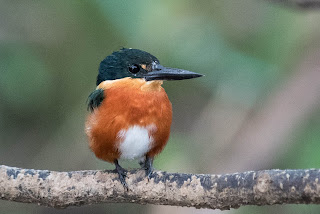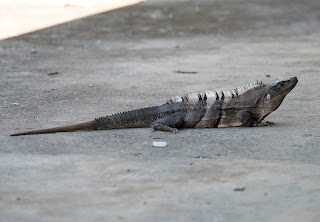And what a brilliant short trip! After a poor spring for birds in Pembrokeshire we needed to get away and try something different. So it was back to our old area, we lived in Letheringsett and Cley for 15 years in total but this was only the third time we'd been back. We stayed in David and Heather Wilson's lovely cottage in Salthouse, to be joined by friends for the middle part of the week.
The first morning we were up early determined to walk to Weybourne or the Coastguard Cottages before breakfast. We were taking it easy on a gorgeous, bright day so I didn't take my camera with me. That was a mistake as it turned out. Just a few metres from the Cottage as we headed for the Skirts track, Kathy asked 'What's this?' and pointed to a small falcon overhead. It was an adult male
Red-footed Falcon, quite low and drifting over the coast road then back towards the marsh. We watched it for about 3 minutes till it drifted further east. It was low enough to see all the details and I was struck again, as I was by the recent Strumble bird, how clearly the orange/red bill and orbital ring showed. I raced back for my camera, hoping we'd catch up with it at The Quags, but no luck, it wasn't seen again. Still we enjoyed some good birds, including Spoonbill over, bumped into Moss Taylor who had seen the Spoonbill circle higher and higher before setting of to the North-east. Then we spent the rest of the day, after breakfast, wandering around the Cley and Salthouse Marshes before Dinner with Penny at The Three Swallows, Cley.
 |
| Spoonbill |
 |
| Coastguard Cottages and Skelding Hill from Kelling Hard |
 |
| Weyboune Camp |
We kept up the before breakfast routine every day, often bumping into Moss and one day being shown round Weybourne Camp, noting the changes made over the years. The rest of the day was spent at Titchwell where we caught up with Bearded Tits for the first time in years, there were also a couple of Red-crested Pochards present amongst huge bio-diversity, as always a bit mind-boggling.
The next morning found us talking to Moss again, at The Camp, when Kathy pointed out a Heron flying over from the west. It was over our heads and it was a first-summer
Purple Heron, to be fair Moss called it first but we all enjoyed amazing views as it was joined by a Grey Heron and they both drifted around between us and Weybourne Beach. The big difference in size was really striking, as was the sharp 'keel' effect of the Purple compared with the grey though the shape from directly below was indistinguishable. It drifted east but came back west a little while later and was subsequently seen further along the coast. Another great bird and we also had a couple of Hobbies through on various mornings.
We walked from Wells to Holkham missing all the breeding Firecrests along the route, as the main part of the day before finding Barn Owl at The Quags in the evening and then the first visit of the trip to The Dun Cow for a really good meal with superb wines chosen by Tony.
After breakfast the next day we met up with Dave Appleton, a mate from the old days and he showed us all round Burnham Overy Staithe and Gun Hill Dunes. Great to meet up again and explore such an amazing set of habitats. Great White Egret, Spoonbills, Cuckoos and a good range of Ducks, Waders, dragonflies and unusual plants. All in blazing sunshine. A really good day.
 |
| Little Tern |
 |
| Greylag Geese |
 |
| Broad-bodied Chaser |
 |
| Ringed Plover |
 |
| Shoveler |
The next day was another amazing day, spent with David and Heather and being shown first the Raptor Watchpoint, then a great lunch and finally the Swanton Novers Great Wood, a relic of the great wild wood which once covered Britain, complete with pingos and stunning history and bio-diversity. It was a real privilege to be invited into this restricted area. Then Kathy was off to Byfords' in Holt for tea with friends.
We spent the final day around Cley and Salthouse, revelling in the rich bird life and finally catching up with some Firecrests at Pretty Corner, though we missed a Glossy Ibis over the marsh as we trundled through the trees. We spent a lovely evening having supper with friends Gill and Philip. A nd on the way home we couldn't find Nightjars on Salthouse Heath though we did see both Red and Muntjac Deer. A nice end to a very sociable and very productive trip. Could almost imagine living there again.





















































































































